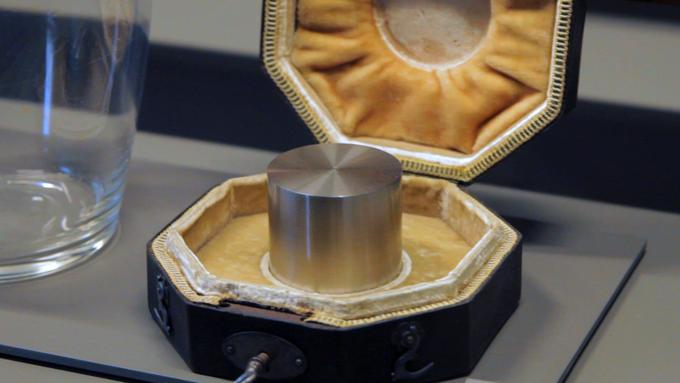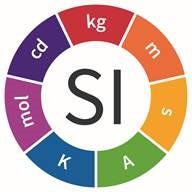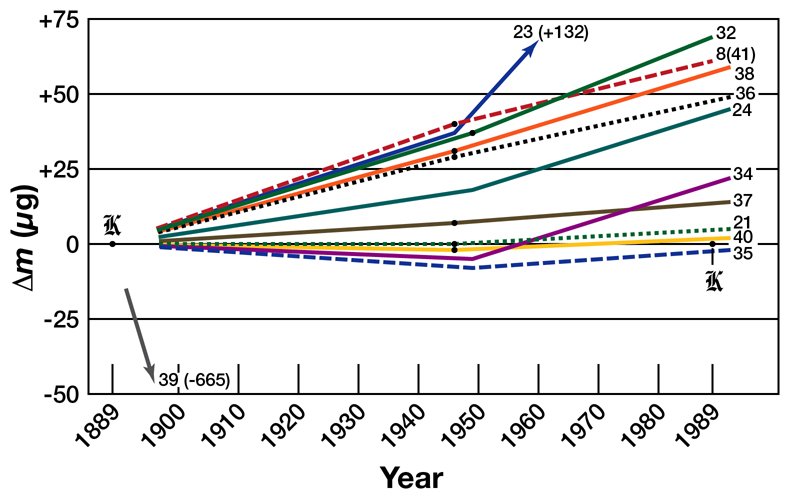An interesting twitter thread by @MaxFagin spooled. Not sure how many people know this.
November is here, and that means a massive shift is coming. And by "massive" I am of course referring to the redefinition of the kilogram unit of mass that the world has been building up to for more than 100 years. Let me explain:
I've had an unhealthy fascination with metrology (the study of measurement) ever since my 2nd year as a physics major when I took a class devoted to duplicating historic physics experiments, so please indulge me for going into heavy detail (get it?) about the kilogram. So what actually defines a unit of measurement? If you're American, you probably know a mile is 5280 feet and a foot is 12 inches and an inch is 2.54 centimeters etc. But where does this chain of definitions end? Is it turtles all the way down? It's actually not! For all units (even the imperial units used in America) the answers all end with the Système International (SI) unit definitions established and maintained for over 100 years by the Bureau International des Poids et Mesures (BIMP) in France. At the base of this tower are the SI base units. Just 7 SI base units define every other unit in existence. They are:
Kilogram, kg (mass)
Meter, m (distance)
Second, s (time)
Kelvin, K (temp)
Ampere, A (electric current)
Candela, cd (luminous intensity)
Mole, mol (quantity)

Every unit you've ever used is "officially" derived from these 7 units. A gallon? Officially 0.003785 m^3. One atmosphere of pressure? Officially 101325(kg/(ms^2) of pressure. 100 Watts? Officially 100 kgm^2/s^3. 12Volts? Officially a 12 kgm^2/(s^3A). Image: [color=rgba(0, 0, 255, 0.45098)]@usnistgov

There's no standard foot or pound sitting in a vault in Washington DC. All units are officially defined (what we call 'traceable') through SI base units. But how are these 7 SI base units defined themselves? Well historically, they were defined by reference to an artifact. For example, in the 1940s, 1 second was defined as 1/86400 the time it takes the Earth to rotate once. In the 1950s, the second was redefined as 1/31556925.9747 the time it takes the Earth to orbit the sun. Finally, in the 1960s, technology advanced enough to redefine the second not from an artifact (like the Earth) but from a fundamental property of the universe. Today the second is defined as the time it takes an electron in a cesium-133 atom to oscillate 9,192,631,770 times. And since we have good reason to believe that electrons are constant properties of our universe, this definition is good everywhere and for all eternity. (And for a memory trick, since it make a year equal to ten million pi seconds long, +/-0.5%.) The meter had a similarly long and remarkable journey. Defined first as 1/10,000,000 of the distance from the equator to the north pole, then as the distance between two marks on a platinum-iridium bar in France,. The meter finally left artifact based definitions behind in the 1960's when timing equipment was precise enough that the meter could be defined as the distance light travels in a vacuum in 1/299,792,458 of a second. And since we have good reason to believe the speed of light is a constant property of our universe, this definition of the meter is good everywhere and for all eternity. (Another memory trick, you can just remember the speed of light is 300 million m/s. That's good to 0.1%) All the other base units in the SI system have long since been redefined in terms of physical properties of our universe that are constant and unchanging. All that is, except the kilogram. Ah, the kilogram! The kilogram has stubbornly eluded redefinition. For 129 years, the kilogram has been defined as just the mass of a physical artifact stored in a vault in France (called the International Prototype Kilogram, the IPK).
Image credit: "The State of the Unit" Unlike time and distance, mass is more difficult to measure precisely, so attempts to create a universal definition of the kilogram have failed to match the precision of simply taking the IPK out of the vault and weighing it every so often. And this is frustrating since, over the last 100 years, there is evidence that the IPK has actually lost some of its material (even though, paradoxically, the IPK is the one object in the entire universe that cannot loose mass.  (So yes, if some careless technician accidentally chipped some metal off the IPK, then the weight we ascribe to atoms would go up. The IPK always weighs 1 kg by definition). Until now that is. Finally, this month, after decades of work and multiple false starts, metrologists are ready to redefine the kilogram by a complex but incredibly precise experimental setup. By measuring the attractive force between two charged plates, and following an incredibly intricate process to calibrate out the effects of the Earth's gravity, the kilogram can now be defined in terms of nothing more than the physical constants of our universe. The BIMP is expected to recommend this new definition be adopted this month, ending a journey begun more than a century ago. The SI unit system will finally be a truly universal system, free of any human artifacts. And that to me is a profoundly beautiful thing.
|